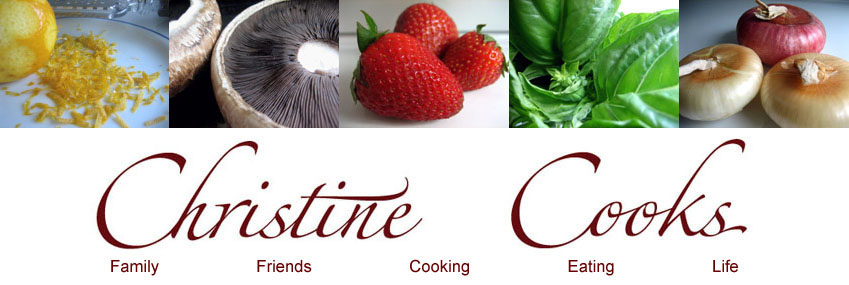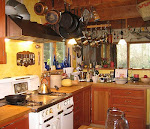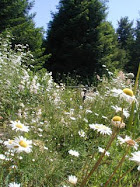One of the things that has been missing from this blog from the very start are posts dedicated to the basics: stocks and broths, salad dressings, sweet and savory sauces, gravies, the "how tos". Sure, some of those things are embedded within a post about soups or stews, crab cakes, dinner salads, and desserts, but very few are the stars of their own page. So one of my goals this year is to remedy that omission.
Herewith is my first Basics: A hearty, rich and robust chicken stock made by roasting chicken bones along with aromatics to a rich, golden, caramelized goodness, pan deglazed, then onto the stovetop to cook into a stock. After that the reduction begins. What you have at the end of the process is a deeply flavored dark stock to enhance soups, stews, braises, risottos, rice and pastas, sauces, or whatever floats your culinary boat.
I began this stock with the carcass (skin and cartilage included) from a previously roasted 5-pound chicken, but you can use backs and wings purchased from your butcher and begin the roasting with this recipe - no need to pre-roast. I do suggest that you always save and freeze the bones, wingtips, etc from any bird that you cook so you always have some on hand to make a stock.
The aromatics (onion, carrot, celery, garlic, spices) all get roasted at the same time with the chicken bones.
A touch of salt, a drizzle of olive oil and into the oven it all goes at 375-degrees for about an hour. I tented the pan with foil for the first 25 minutes then let it go naked for the remainder of roasting time.
Instead of deglazing the roasting pan with wine at the end of the cooking time (which is what I normally do), about two-thirds of the way through I removed the pan from the oven, quartered a very ripe Meyer lemon
(thanks Bill!) and drizzled the juice over the pan contents, scraping up the browned bits from the bottom with a spatula, dropping the spent lemon parts into the pan, and continued roasting until it was all done to a golden perfection.
Bones, veggies, lemon pieces, spices, browned bits and all went into a large stockpot along with bruised fresh bay leaves, sprigs of fresh thyme, a small hot red
Padrón pepper from a plant that is struggling mightily in my greenhouse, some sea salt and 12 cups of fresh, cool water (preferrably non-chlorinated).
After simmering for an hour, the yield was 11 cups of delicious stock. And really, you could stop right there and start making soup, but I wanted my stock to be richer, more concentrated and de-fatted, so I strained it through 2 layers of cheesecloth and put it in the fridge overnight to cool, allowing the fat to congeal on the surface. The next day it was easy to skim the fat from the surface of each container.
Again using 2 layers of cheesecloth and a fine mesh strainer, I strained the stock back into a stockpot, brought it to just under a boil, lowered the heat to a simmer and let it reduce down to 6 cups - about 40 minutes total. The flavors were fantastic, the stock the deep, rich brown that you see in the top photo. Four cups of it are freezing in ice cube trays as I type this, the remaining 2 cups are in the freezer to be used as a soup base later in the week. I think you're gonna like this.
Christine's Roasted Rich and Robust Chicken Stock
Ingredients:
Carcass of one 5-pound or two 2 1/2-pound chickens, cut into pieces, preferrably previously roasted
1 large sweet yellow or cippolini onion, peeled and coarsely chopped
3 large carrots, peeled and coarsely chopped
4 stalks celery, coarsely chopped
10 or so cloves garlic, peeled and left whole
1/2 teaspoon each whole black peppercorns and whole allspice berries
1 Meyer lemon, washed, quartered, seeds removed
2 fresh bay leaves, bruised
4 long sprigs fresh thyme
1 small hot pepper, stem removed, jalapeno will do, I used
Pimiento de Padrón, from my greenhouse
1 teaspoon fine kosher salt or sea salt
2 teaspoons olive oil, about
12 cups cool, fresh water
Preparation:
Preheat the oven to 375-degrees
Place the chicken parts, onions, carrots, celery, garlic cloves, peppercorns and allspice berries in a large roasting pan and drizzle with the olive oil. Shake the pan to distribute the oil.
Tent the pan loosely with foil and put in the oven for 20-30 minutes.
Remove the foil and drizzle the pan contents with the juice of the Meyer lemon, dropping the lemon pieces into the pan. Scrape the pan with a spatula to loosen the browned bits from the bottom and return pan to the oven for another 30 minutes or until the bones and vegetables are golden brown. Be sure to not let the garlic cloves burn. That would be a bad thing.
Scrape the contents of the roasting pan into a large stockpot and cover with 12 cups water.
Add the bay leaves, thyme sprigs, hot pepper and the salt and give it a stir.
Bring to just under a boil over medium-high heat. If scum rises to the top, use a skimmer or fine mesh sieve to remove it then reduce the heat to a simmer and allow the stock to cook this way for 1 hour. Check the heat periodically to maintain a simmer, not a boil.
Remove the stockpot from the heat and allow the stock to cool for 30 minutes.
Remove as much of the solids as you can with a slotted spoon then pour the stock through 2 layers of cheesecloth in a large sieve into glass containers.
Place the containers in the refrigerator for 8-10 hours or overnight so the fat can rise to the top and congeal.
Remove the stock from the fridge and skim any hard fat from the surface (your doggies and kitties will be waiting for this part; there's nothing like a little chicken fat to liven up a dish of kibble).
Using 2 layers of cheesecloth and a fine mesh strainer, strain the stock into a large stockpot over medium-high heat and bring to just under a boil.
Lower the heat to a simmer and reduce the stock to about 6 cups; about 30 minutes simmer time.
Allow the reduced stock to cool then strain it again, for the last time, through 2 layers of cheesecloth and a fine mesh strainer. I know all that straining may seem like a lot, but I think you will be happier with a stock that doesn't end up with grit at the bottom.
When the stock has cooled, you can pour it into ice cube trays, freeze them hard then remove them from the trays into freezer-proof ziptop bags, label and date the bags, and put in the freezer. Or, you can pour the stock into freezer-type storage containers in any volume you prefer and freeze.
The stock will keep well in the freezer for up to 6 months but, honestly, once you taste this you'll want to use it up sooner. And that's good because you can always make more.
Enjoy!







































